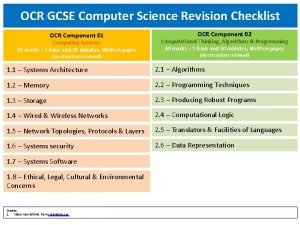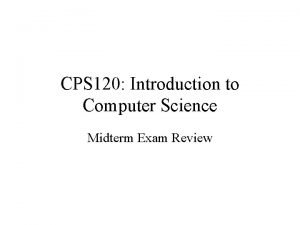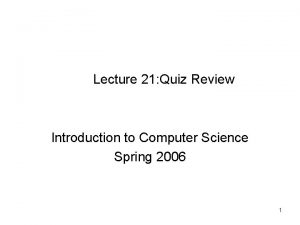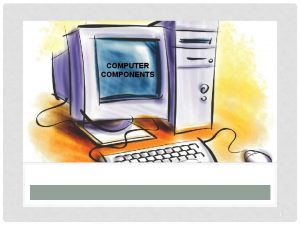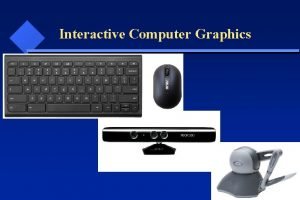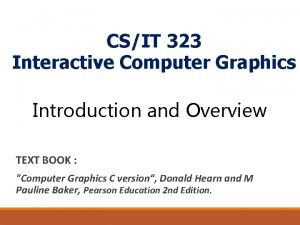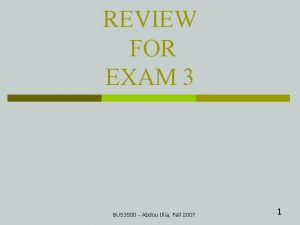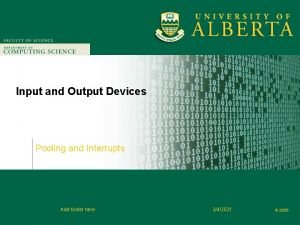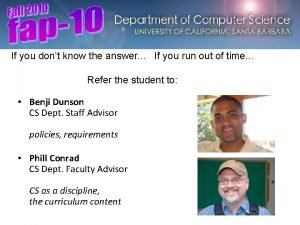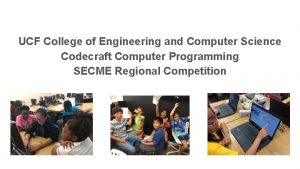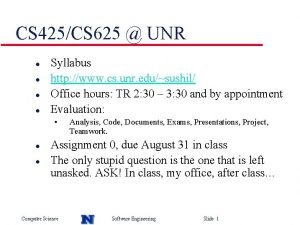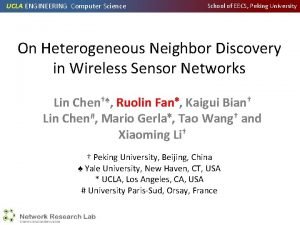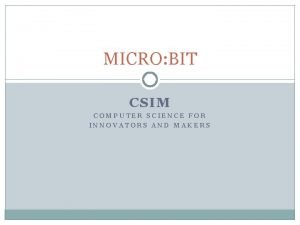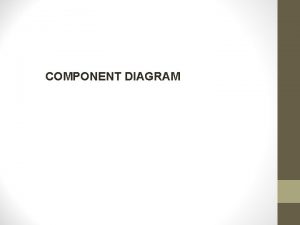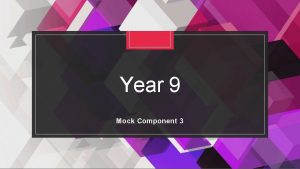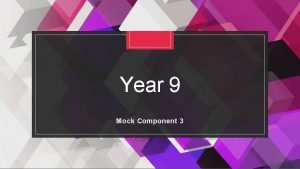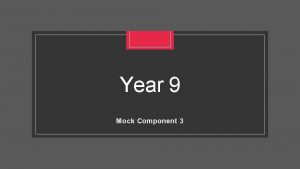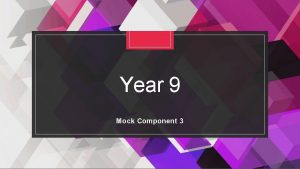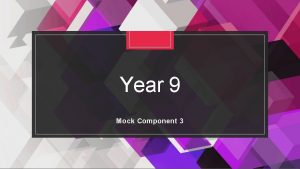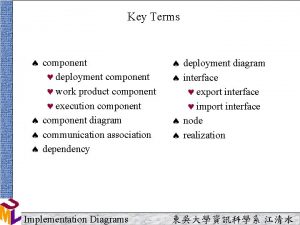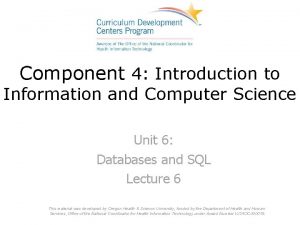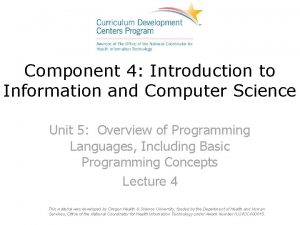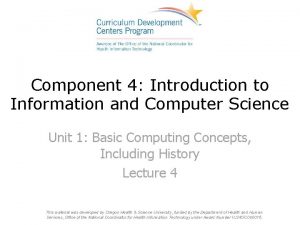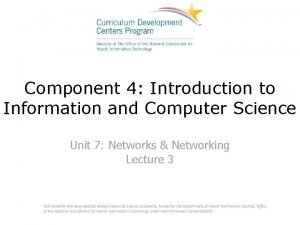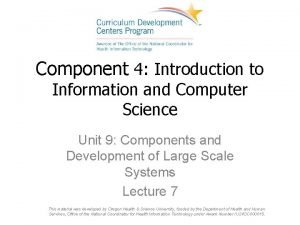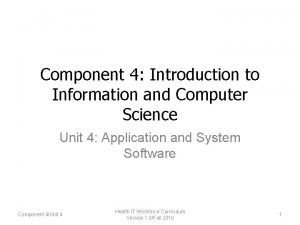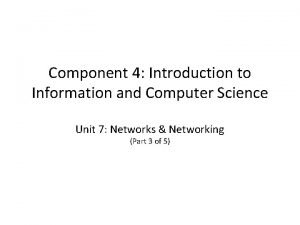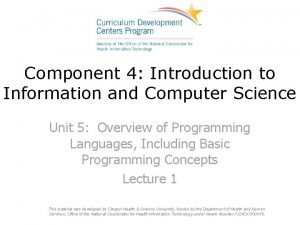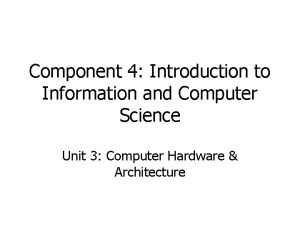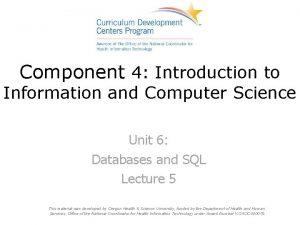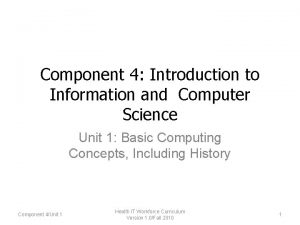Component 4 Introduction to Information and Computer Science

























- Slides: 25

Component 4: Introduction to Information and Computer Science Unit 2: Internet and the World Wide Web

Unit Objectives • Definition of the Internet and World Wide Web. • Connecting to the Internet. • Searching the Internet, filtering results and evaluating credibility of results. • Internet security and privacy concerns. • Ethical considerations of the Internet. • Online healthcare applications and associated security and privacy issues (including HIPAA). Component 4/Unit 2 Health IT Workforce Curriculum Version 1. 0/Fall 2010 2

What Devices are Usually Attacked? • Routers ü Sends traffic from a private network to the Internet and from the Internet to a private network. ü If a hacker can successfully attack a router: Ø All network traffic can be viewed. Ø Traffic can be redirected to the hacker’s equipment. Component 4/Unit 2 Health IT Workforce Curriculum Version 1. 0/Fall 2010 3

What Devices are Usually Attacked? (cont’d) • Web Servers ü House Web sites. ü If a hacker can successfully attack a Web server, the Web server may not be able to function properly. ü What would happen if Amazon. com or e. Bay. com went down for an entire business day? Component 4/Unit 2 Health IT Workforce Curriculum Version 1. 0/Fall 2010 4

What Devices are Usually Attacked? (cont’d) • Computers ü Computers can store confidential personal and corporate data. ü If a hacker can gain access to this information, they might use it for personal gain, sell it to another party, or use it for blackmail purposes. Component 4/Unit 2 Health IT Workforce Curriculum Version 1. 0/Fall 2010 5

How do Hackers Attack Devices? • Packet sniffers can read Internet traffic. • Install malware. ü Adware – Continuous ads on your screen. ü Spyware – Reports on sites you visit. • Guess at user names and passwords. ü Don’t use easy-to-guess passwords. ü Do change default usernames and passwords (wireless routers). Component 4/Unit 2 Health IT Workforce Curriculum Version 1. 0/Fall 2010 6

Secure Your Operating System • Install critical updates ü For Windows operating systems (OS), critical updates fix security flaws and should be installed as soon as they are released. ü Optional updates should not be automatically installed. ü Only install optional updates if you determine that they are needed. Component 4/Unit 2 Health IT Workforce Curriculum Version 1. 0/Fall 2010 7

Secure Your Files • Install anti-virus (AV) protection software ü Commercial AV software is more robust than free AV software. Ø Will catch and quarantine almost all Trojan horse, virus, and worm attacks before they do any harm. ü AV software works by recognizing “patterns” and stopping what it considers bad behavior. Ø Patterns should be updated daily to protect computer against new attacks. ü If you decide to install more than one AV program on your computer, verify that they will work together before installation. Ø Some AV software do not work well together. Component 4/Unit 2 Health IT Workforce Curriculum Version 1. 0/Fall 2010 8

Engage in Safe Browsing • When surfing never click on a popup unless you are absolutely sure of its owner ü Some popups may indicate that the computer is infected with viruses and that you should click the popup to cleanse your system. Ø Never trust these messages. It is more likely that your AV software will locate and remove malware and viruses than a Web site’s software. Component 4/Unit 2 Health IT Workforce Curriculum Version 1. 0/Fall 2010 9

Close Popup Windows Safely • Press the key combination of ALT+F 4 to terminate popups. This ensures that the popup will not install malware. • Do not click anywhere on or in the popup window with your mouse. Clicking may install malware. Component 4/Unit 2 Health IT Workforce Curriculum Version 1. 0/Fall 2010 10

Secure Your Computer System • Turn on a firewall ü Firewalls permit or deny a computer the ability to connect to another computer. ü The firewall will disable ports that should not be open and restrict use of ports to certain programs. Component 4/Unit 2 Health IT Workforce Curriculum Version 1. 0/Fall 2010 11

Manage Cookies • A cookie is a text file that a Web site stores on your computer. • Cookies cannot harm your computer. • Web sites use cookies to keep track of your preferences and to record Web pages you visit. ü First party cookies are placed on your computer by Web site owners. These are usually okay. ü Third party cookies are placed on your computer by companies authorized by the Web site owner to place a cookie on your computer. Ø Some experts recommend accepting first party, rejecting third party, and allowing session cookies. Component 4/Unit 2 Health IT Workforce Curriculum Version 1. 0/Fall 2010 12

Manage Cookies (cont’d) • Recommended settings in Internet Explorer… Component 4/Unit 2 Health IT Workforce Curriculum Version 1. 0/Fall 2010 13

Passwords and the Internet • Use complex passwords: ü ü ü At least six characters. At least one upper-case character. At least one number. At least one symbol (# ! @ $ %, etc. ). Never use common information in a password. • Do not write passwords on paper. ü Hackers know to search around the monitor, keyboard, and general computer area to find passwords. Component 4/Unit 2 Health IT Workforce Curriculum Version 1. 0/Fall 2010 14

Know Who Uses Your Computer • Utilize user accounts on your computer ü Don’t log in using the “administrator” account. ü Tracks who has logged in and some of the things they do while logged in. • Require all computer users to have their own user account and password. ü Don’t set up users as administrators. • Set users as Power Users or Users to decrease the chances of them infecting your computer. Component 4/Unit 2 Health IT Workforce Curriculum Version 1. 0/Fall 2010 15

Other Internet Security Considerations • Never use a public computer to conduct personal business. • Use your personal computer with commercial, up-to-date AV software installed. • Use strong passwords on all online accounts to prevent others from viewing or stealing your data. • Always log out of any session you logged into before leaving the computer. • Never open an e-mail from an unknown recipient. Ø Don’t even click it once. • Never open or save an e-mail attachment unless you know and trust the sender. Component 4/Unit 2 Health IT Workforce Curriculum Version 1. 0/Fall 2010 16

Trojans, Viruses, and Worms • A Trojan horse is a malware program that usually impersonates a known good file installed on the system by replacing (deleting) the good file. ü Gets its name from the Greek Trojan Horse myth. ü The Trojan then does its dirty work on a certain date, through a user action, or on command. ü Trojans can destroy or copy data, install adware, or install a browser toolbar. ü Trojans can record keystrokes and send this to the attacker and scan computer ports. Component 4/Unit 2 Health IT Workforce Curriculum Version 1. 0/Fall 2010 17

Trojans, Viruses, and Worms (cont’d) • A virus is computer program that can harm a computer and make it inoperable. Some viruses are only an annoyance. ü Viruses usually do not replicate (make copies of) themselves on other computers. ü Removing the virus usually cleans the computer. ü Sending a virus via e-mail may replicate the virus. ü In 2008, the Fun. exe virus spread itself via e-mail throughout the world and was very difficult to remove as it made many copies of itself on an infected computer. Component 4/Unit 2 Health IT Workforce Curriculum Version 1. 0/Fall 2010 18

Trojans, Viruses, and Worms (cont’d) • Macro viruses usually infect Microsoft Office files and install themselves when users click files. ü A macro is a small program, usually written in VBA (Visual Basic for Applications). ü Macro viruses spread when users click files in which the macro virus resides. ü Macro viruses may also delete files, etc. on an infected system. Component 4/Unit 2 Health IT Workforce Curriculum Version 1. 0/Fall 2010 19

Trojans, Viruses, and Worms (cont’d) • A worm is a program that works to create a lot of network traffic. ü Some worms are not malware as they crawl the network searching for reporting information. ü Most worms replicate themselves, making the network unusable. ü The ILOVEYOU worm successfully attacked millions of computers (users clicked the attachment) in May 2000. Component 4/Unit 2 Health IT Workforce Curriculum Version 1. 0/Fall 2010 20

Trojans, Viruses, and Worms (cont’d) • Phishing ü Phishing is an attempt to trick you into revealing personal information to an attacker so they can impersonate you. ü Pronounced like the word “fishing, ” the attacker is fishing for information about YOU! ü You may receive an e-mail that appears to be from your financial institution, e. Bay, or Amazon, asking you to login to verify a transaction. Component 4/Unit 2 Health IT Workforce Curriculum Version 1. 0/Fall 2010 21

Trojans, Viruses, and Worms (cont’d) ü When you click the link in the email, the Web site looks as you expect it to. ü No reputable organization will every ask you to do this. ü Report the attack to your organization so they are aware of the attack. Most companies will act on reported phishing attempts. • Most e-mail software includes the ability to monitor for phishing and move the suspected email to a non-functional (Junk e-mail) folder. Component 4/Unit 2 Health IT Workforce Curriculum Version 1. 0/Fall 2010 22

Trojans, Viruses, and Worms (cont’d) • Hoaxes ü Hoaxes are usually harmless and attempt to convince you of something that is not true. ü Hoaxes usually come in the form of an e-mail. ü Some hoaxes invite you to send money to someone in another part of the world, others ask you to contribute to find missing children, etc. ü Use your search engine to determine whether the email’s message is true by entering the e-mail subject line in a search engine. ü The result will usually indicate whether the email is a hoax. Component 4/Unit 2 Health IT Workforce Curriculum Version 1. 0/Fall 2010 23

Trojans, Viruses, and Worms (cont’d) • Uncloak a Hoax ü Use trusted Internet sites to detect hoaxes. ü Snopes. com - http: //www. snopes. com/. ü Urban Legends Online http: //urbanlegendsonline. com/. • Never forward e-mail chains without verifying their source. Component 4/Unit 2 Health IT Workforce Curriculum Version 1. 0/Fall 2010 24

Ethical considerations of the Internet • Sharing Internet connection with neighbors. ü Should neighbors have the ability to pool together, lease an Internet connection from an ISP, and pay for shared one connection? • Downloading software from the Internet. ü Should license “key generator” sites be allowed to operate? ü Should people be able to download pirated software from the Internet? ü Pirating software is a copyright infringement; selling unauthorized copies of commercial software, usually at a very low price. Component 4/Unit 2 Health IT Workforce Curriculum Version 1. 0/Fall 2010 25
 Computer science component 1
Computer science component 1 K5 think central
K5 think central Eric’s favourite .......... is science. *
Eric’s favourite .......... is science. * Introduction to computer science midterm exam
Introduction to computer science midterm exam Introduction to computer science midterm exam test
Introduction to computer science midterm exam test C++ code
C++ code Python programming an introduction to computer science
Python programming an introduction to computer science Examples of software component
Examples of software component Computer component definition
Computer component definition Interactive computer graphics notes
Interactive computer graphics notes The component of interactive computer graphics are
The component of interactive computer graphics are Lincoln pizza ordering system dfd
Lincoln pizza ordering system dfd Natural science and social science similarities
Natural science and social science similarities Soft science definition
Soft science definition Health and social care component 3 health and wellbeing
Health and social care component 3 health and wellbeing Computer science input and output
Computer science input and output Difference between ba and bs in computer science
Difference between ba and bs in computer science Ucf software engineering
Ucf software engineering Erik jonsson school of engineering and computer science
Erik jonsson school of engineering and computer science Computer science and engineering unr
Computer science and engineering unr Ucla
Ucla Computer science for innovators and makers
Computer science for innovators and makers Erik jonsson school of engineering and computer science
Erik jonsson school of engineering and computer science Erik jonsson school of engineering and computer science
Erik jonsson school of engineering and computer science Swot analysis library
Swot analysis library Objective of computer system
Objective of computer system
